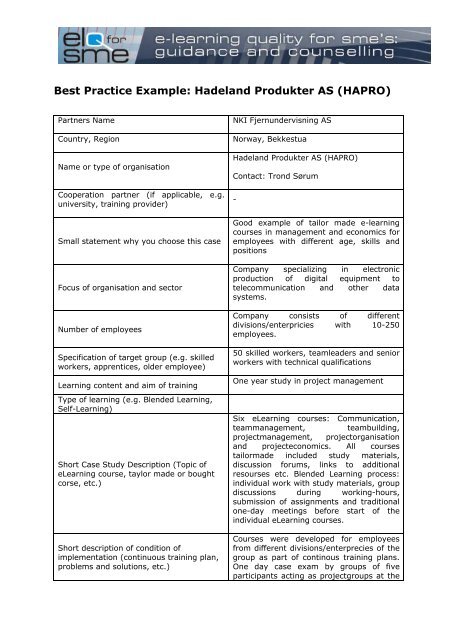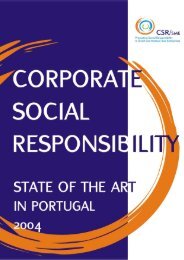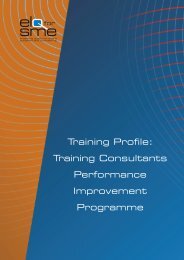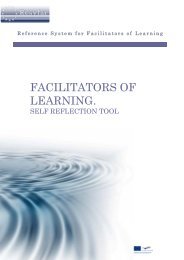Best Practice Example: Hadeland Produkter AS (HAPRO) - Cecoa
Best Practice Example: Hadeland Produkter AS (HAPRO) - Cecoa
Best Practice Example: Hadeland Produkter AS (HAPRO) - Cecoa
Create successful ePaper yourself
Turn your PDF publications into a flip-book with our unique Google optimized e-Paper software.
<strong>Best</strong> <strong>Practice</strong> <strong>Example</strong>: <strong>Hadeland</strong> <strong>Produkter</strong> <strong>AS</strong> (<strong>HAPRO</strong>)<br />
Partners Name<br />
Country, Region<br />
Name or type of organisation<br />
Cooperation partner (if applicable, e.g.<br />
university, training provider)<br />
Small statement why you choose this case<br />
Focus of organisation and sector<br />
Number of employees<br />
Specification of target group (e.g. skilled<br />
workers, apprentices, older employee)<br />
Learning content and aim of training<br />
Type of learning (e.g. Blended Learning,<br />
Self-Learning)<br />
Short Case Study Description (Topic of<br />
eLearning course, taylor made or bought<br />
corse, etc.)<br />
Short description of condition of<br />
implementation (continuous training plan,<br />
problems and solutions, etc.)<br />
NKI Fjernundervisning <strong>AS</strong><br />
Norway, Bekkestua<br />
<strong>Hadeland</strong> <strong>Produkter</strong> <strong>AS</strong> (<strong>HAPRO</strong>)<br />
Contact: Trond Sørum<br />
-<br />
Good example of tailor made e-learning<br />
courses in management and economics for<br />
employees with different age, skills and<br />
positions<br />
Company specializing in electronic<br />
production of digital equipment to<br />
telecommunication and other data<br />
systems.<br />
Company consists of different<br />
divisions/enterpricies with 10-250<br />
employees.<br />
50 skilled workers, teamleaders and senior<br />
workers with technical qualifications<br />
One year study in project management<br />
Six eLearning courses: Communication,<br />
teammanagement,<br />
teambuilding,<br />
projectmanagement, projectorganisation<br />
and projecteconomics. All courses<br />
tailormade included study materials,<br />
discussion forums, links to additional<br />
resourses etc. Blended Learning process:<br />
individual work with study materials, group<br />
discussions during working-hours,<br />
submission of assignments and traditional<br />
one-day meetings before start of the<br />
individual eLearning courses.<br />
Courses were developed for employees<br />
from different divisions/enterprecies of the<br />
group as part of continous training plans.<br />
One day case exam by groups of five<br />
participants acting as projectgroups at the
end of courses.<br />
Success factors in General<br />
Success factors: organizational factors<br />
(internal to the company)?<br />
Success factors: pedagogical factors<br />
(improvement of leaders skills)?<br />
Success factors: businness factors (marked<br />
orientation, ROI)<br />
Other Success factors<br />
The flexibility of eLearning courses. The<br />
Blended Learning form seemed to meet<br />
exactly the needs of the target group.<br />
Reorganisation of the production in flexible<br />
smaller groups with project leaders<br />
Use of PC and electronic medium as well as<br />
independent study skilles were improved<br />
Both participants and company agrees on<br />
positive ROI<br />
Focus on quality on time consuming<br />
activities, that be time spent on leisure or<br />
work<br />
Pictures, screenshots, etc attached to this<br />
template?<br />
Yes<br />
No
Quality criteria grid for eLearning<br />
First impressions:<br />
Tick if<br />
appropriate<br />
for your<br />
example<br />
Learning objectives and content are clearly defined<br />
The learning content is relevant to the work your employees actually do<br />
(practical examples; tools that are helpful and useful for work and that<br />
help learners apply their coursework to everyday situations)<br />
The program is modularised<br />
Learners can define their own path through the material<br />
Learners can make notes directly in the program<br />
The software automatically generates logs of individual sessions<br />
The software is optimised for use with industry standard browsers (like<br />
Internet explorer or firefox, etc.)<br />
Industry standard IT equipment can be used; no unusual technologies or<br />
formats are needed<br />
General Comments<br />
After closer scrutiny:<br />
The times indicated for task completion are realistic<br />
The course content is clearly mapped; graphics are also used for this<br />
purpose<br />
The page layouts are clear and not overloaded with text<br />
Texts are clear and legible. Longer passages are subdivided into<br />
manageable segments<br />
Navigation icons are intuitively understandable, logically positioned, and<br />
readily accessible<br />
The navigation software isn’t “drowning” in icons<br />
The links clearly indicate where the learner should go next<br />
The learner can contact the help centre and/or a facilitator at any time<br />
All hyperlinks are active
e-tutors have good online media skills and exhibit professional<br />
competence<br />
Feedback times are short (e.g. users receive responses within one<br />
working day)<br />
The software fully taps the interactive potential of the medium<br />
General Comments<br />
Internet services: WWW, e-mail and chat<br />
The option to do assignments and send them to the facilitator<br />
Query function<br />
Support services<br />
Users can interact with each other online<br />
Users can create their own homepages<br />
Lists of frequently asked questions (FAQ)<br />
Bulletin boards or Newsletters<br />
Discussion boards or Forums<br />
Chatrooms<br />
General Comments<br />
Additional options<br />
Application sharing in virtual work groups<br />
Simulations<br />
Hotlines for assisstance<br />
Conference calls<br />
Video conferences<br />
General Comments<br />
Additional opportunities for direct interaction
Getting acquainted sessions at initial course meetings (for getting to know<br />
other course participants)<br />
Establishment of in-company study groups<br />
Concurrent and/or closing course meetings<br />
Support for on site coaching<br />
Consultation services for commissioning/implementation<br />
Technical support is available<br />
Course participants receive a certificate at the end of the course<br />
General Comments<br />
Summing up – Quality criteria of eLearning courses/providers at a<br />
glance<br />
The offered demo-versions provide an insight into topics and structure of<br />
the course<br />
Description of the proportion between stand-alone-learning and learning<br />
in group<br />
Detailed description of topics<br />
Self-tests, correction of homework by tutors and discussions with other<br />
participants are planned.<br />
Detailed information about expertise and methodical competence.<br />
Are tutors or course instructor available at any time?<br />
Individual supervision, individual needs are respected.<br />
It is possible to communicate with other participants and to discuss<br />
exercises and solutions. Chat times concerning different topics re<br />
appointed.<br />
Exact description of prerequisites and audiences.<br />
Exact description of time requirements<br />
Exact description of technical requirements.<br />
A technical support is offered<br />
General Comments<br />
This project has been funded with support from the European Commission. This publication reflects the views only of<br />
the author, and the Commission cannot be held responsible for any use which may be made of the information<br />
contained therein.








